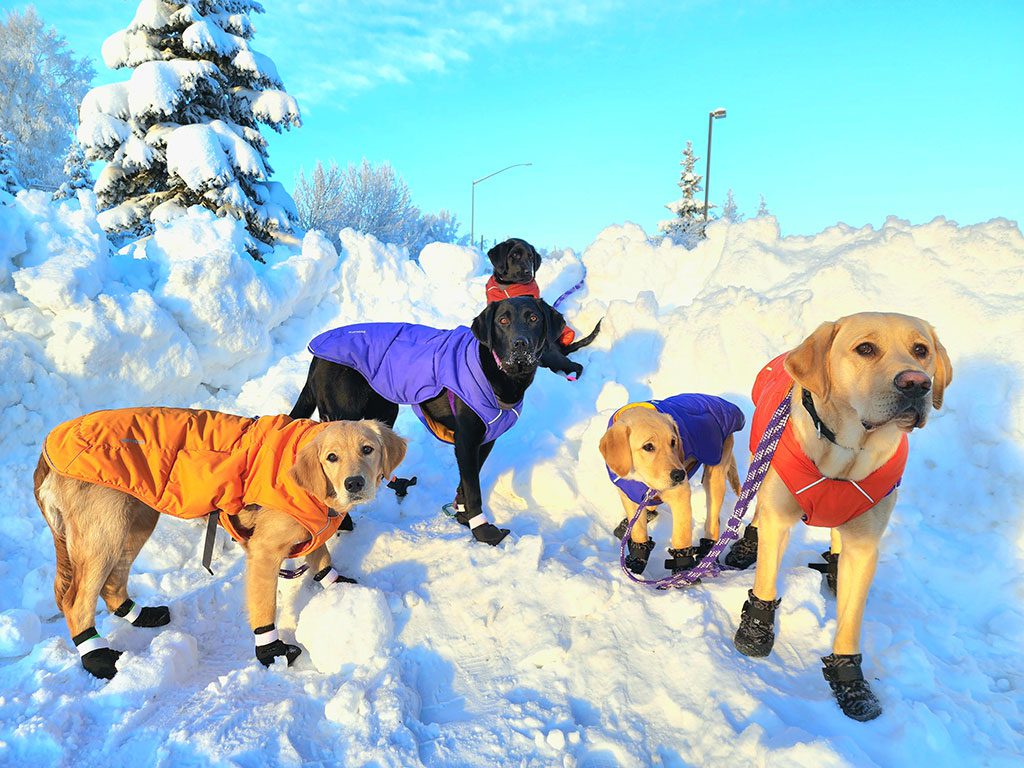Winter Pet Safety
The holidays are here and winter is coming! While the holiday season primarily revolves around gift-giving and spending time with loved ones, it’s important to keep in mind that this season also brings on harsh weather that could affect your pets. At Paws for Purple Hearts, the safety of our Service Dogs-in-Training is of the utmost importance.
While each region may face its own levels of winter weather, the safety practices we use to keep our pups safe are the same across the board. For example, while the San Antonio team rarely experiences snow, they still ensure that the dogs aren’t outside in the cold for too long, wear booties when the temperature is too cold, and have a dry and warm space to rest inside. On the other side of the nation, however, our Alaska team frequently experiences extreme cold and weather conditions.
The Alaska team demonstrates how much of a high priority it is to ensure that their pups-in-training are properly dressed for the inclement weather. Their dogs learn to wear winter accessories like coats and booties to keep them warm to prevent any irritation or damage to their paws.
Tips to Keep Your Pet Safe
While some regions may not experience as harsh of winters as others, it is still best to implement proper weather safety practices for your furry friends. Here are five tips to keep in mind:
- Keep your pets indoors whenever possible.
If you feel that the weather is too cold for you to be outside, then chances are that it’s too cold for your pet. Don’t keep your pets outside for long periods during very cold weather. Also keep in mind that while long-haired dogs may tolerate colder temperatures better, short-haired dogs may need a coat or sweater during walks. - Provide an outdoor shelter for your pets.
If your dog is an outdoor dog, make sure they have a dry, draft-free doghouse that is large enough for them to sit and lie down in, but small enough to retain their body heat. Also, make sure that the doghouse is elevated a few inches off the ground, and use cedar shavings or straw to cover it. Lastly, make sure the doghouse has an entrance that faces away from heavy winds and includes a flap made of heavy, waterproof fabric or heavy plastic. - Proper feet care.
Salt and other chemicals that are used to melt ice and snow can harm your furry friend’s paws. After walking your pet outside, be sure to gently rub the bottom of your pet’s paws with a damp towel to remove any irritants, or buy dog boots to prevent any possible paw irritation. During your walks, you should also be mindful of signs that your pet’s feet are uncomfortably cold. This can include frequently lifting their paws, whining, or stopping altogether. - Keep your pets leashed near water.
If your walking route includes walking by bodies of water, keep your pets on a leash, especially if the body of water is frozen. You want to prevent any possibility of your pet running onto the ice and potentially falling through. - Do not lock pets in your car.
Similar to those hotter months of the year, refrain from locking your pets in the car. While you may not be dealing with summer heat, cars can act like a refrigerator in the winter, holding in cold air and putting your pet at risk.
We hope these tips help you keep your pet safe this winter season! Have a safe and happy holiday season!
Looking to help our cause? We couldn’t do what we do without our supporters! Please consider helping us spread the word about our mission to your community. Your support allows us to continue to fulfill our mission in helping Veterans and Active Duty Service Members. By simply helping us get the word out there, you are helping us to continue to fulfill our mission. Please also consider a monetary donation or donating from our Amazon Wishlist to help our cause.






 Combined Federal Campaign (CFC) #43093
Combined Federal Campaign (CFC) #43093